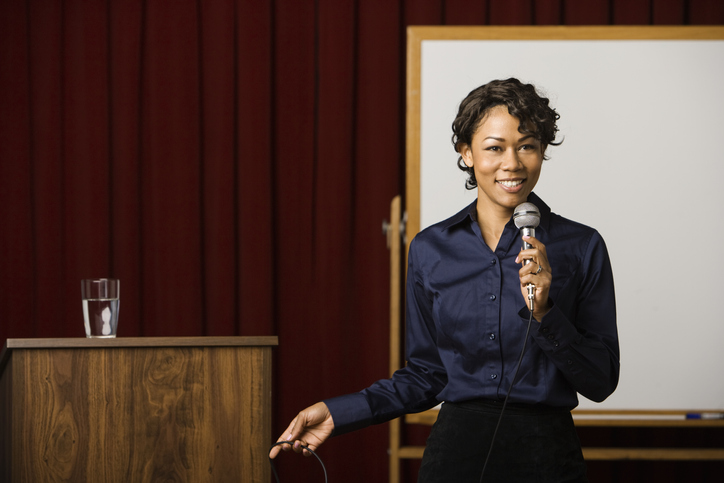My grandmother has been blind for half of her life. She doesn’t “look blind,” meaning there is no outward clue for a sighted person to realize that she cannot see instantly. My grandmother, with her movie star looks, usually does not use her white cane in public. Her eyes sparkle even though no light is coming in. Far too often when people discover she cannot see, they stop talking to her directly and turn their attention to the sighted person beside her. Even without vision, she knows when someone stops focusing on her.
This awkward circumstance applies to public speaking, too. If you don’t acknowledge someone who is right in front of you, why should they pay attention to you? This is where eye contact comes into play.
Whether you are trying to persuade your team to adopt a new policy or tell a story to outside stakeholders, direct eye contact will help you engage them. Here are five tips to improve eye contact and make you appear more confident in your speech-making.
1. Mirror mirror
Take a moment to look yourself in the eyes before a mirror, and get comfortable with looking at you. Holding that gaze, have a conversation with yourself. If you are relaxed looking at you, an audience will be too.
2. The eye color experiment
Making eye contact can be the most anxiety-producing aspect of public speaking, but it is an activity that gets easier over time. While gathering with a small group of your friends, see if you can determine the color of their eyes. There’s no need to announce this experiment beforehand, nor should you get up close and personal to find the answer. Once this personal experiment yields results, add others to the mix. Can you determine your coworkers’ eye color just by glancing at them? If so, you are making eye contact.
3. Three Mississippis
Eye contact does not mean burning the corneas of your audience members. Making contact for too long a period can be uncomfortable for your listener. Use the “Three Mississippis” rule as you work on this skill. When making eye contact with someone in the audience, your gaze should last no longer than three seconds (“One Mississippi, two Mississippi, three Mississippi”). It may be tough to juggle the real-time counting of Mississippis in your head while making your presentation. This reality brings us to the next tip.
4. A gaze for a sentence
Use your speech to dictate how long you make eye contact as your skills improve. For example, look at one audience member for every sentence you utter and then move to another person for the following sentence. You can gauge how long to look at each person as you improve.
5. Vision superpowers
Even when you become a pro at making eye contact during a speech, your listeners will only sometimes be as savvy. Some audience members will never look at you; some will appear disinterested. Some may be as anxious as you may be and will avoid glancing your way. You need to keep talking and maintain eye contact regardless. Sometimes, by looking at someone directly, you will actually command their attention (that’s the superpower!).
Using eye contact during your speech will make you appear confident and prepared, no matter the circumstances surrounding you.
Opinions expressed by SmartBrief contributors are their own.
____________________________________
Take advantage of SmartBrief’s FREE email newsletters on leadership and business transformation, among the company’s more than 250 industry-focused newsletters.
